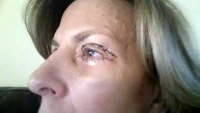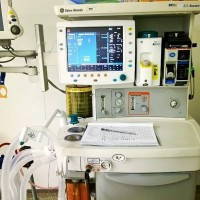Eyelid Surgery No Anesthesia
Eyelid surgery without anesthesia
Eyelid surgery can be easily done with local anesthesia, with or without sedation (twilight anesthesia). The local anesthesia allows the area to be numb and also reducing bleeding/bruising.
If you choose to have the procedure done without sedation, you will feel some stinging during the injection and possibly when the fat is trimmed. (Randy J. Buckspan, MD, Miami Plastic Surgeon)
Upper Lid Lifts (Blepharoplasty) CAN be done under local anesthesia, local anesthesia supplemented by either anxiety calming pills OR anxiety calming intravenous medication and finally under general anesthesia.
The mode of anesthesia depends on your wishes and what if any other procedures are done as well. (Peter A. Aldea, MD, Memphis Plastic Surgeon)
Choosing anesthesia for eyelid surgery
Eyelid surgery without any form of anesthesia would be cruel and unusual punishment. But I’m sure you are asking if eyelid surgery can be done without general anesthesia.
And the answer is a definite yes. In fact, nearly everything that plastic surgeons do can be done without general anesthesia.
Your choices for eyelid surgery are three: Local, Local with sedation, and general anesthesia.
With local anesthesia you will feel the injections of the anesthetic and may have moments of pain during surgery which will prompt your surgeon to inject more local to give you relief.

The eyelid surgery no anesthesia pictures
With sedation and local the same is true only you will not remember the experience at all. Sedation makes surgery a lot more comfortable without placing a tube in your throat and helping you breathe. When having surgery under general anesthesia you will have absolutely no pain during surgery and have no memory of the entire process. It is the most comfortable option, though probably takes the longest to wake up from after surgery. The risks and benefits of these choices are debatable and should be discussed with your anesthesiologist. If you have a strong preference for any of the above choices, your surgeon should be able to accommodate your wishes. (Adam Rubinstein, MD, Los Angeles Oculoplastic Surgeon)
Blepharoplasty should get local anesthesia at minimum

Eyelid surgery no anesthesia pictures
Blepharoplasty is a procedure that can be easily be done under local anesthesia. While not necessary, we like to administer sedation in addition to help make the procedure more comfortable. This can range from simple oral sedation to IV sedation. (Corey S. Maas, MD, San Francisco Facial Plastic Surgeon)
Need sedation for best blepharoplasty results.
I don’t believe in cutting corners. To get the best possible result with a blepharoplasty, the patient needs to be quiet, relaxed, and comfortable. That’s why we insist on sedation along with local anesthesia. (George J. Beraka, MD (retired), Manhattan Plastic Surgeon)
Blepharoplasty under local anesthesia

Eyelid surgery no anesthesia image
Blepharoplasty is commonly done safely and comfortably under local anesthesia. Other options include sedation or general anesthesia. Discuss all with your surgeon to see which is best for you (Dean Fardo, MD, Atlanta Plastic Surgeon)
Eyelid surgery without sedation or anesthesia is possible but depends on a few factors: Which eye lid is being treated. Generally, upper eyelid surgery can performed with local anesthesia i.e. numbing injections along with oral medication such as Valium to relax the patients.

Lower eyelid surgery no anesthesia
Lower eye lid surgery where fat is being removed requires some form of sedation anesthesia. Fat vs skin removal: Again, if only skin is being removed from the upper and lower eye lids, sedation anesthesia is not required. This includes laser resurfacing of the eye lids. Surgeons comfort without anesthesia as well as patients level of comfort with this approach. In general, using tiny needles for the Novocaine injections combined with an oral relaxing medicine such as Valium, background music and caring staff make all the difference in being able to perform surgery without sedation. (Ran Y. Rubinstein, MD, Manhattan Facial Plastic Surgeon)
Can Eyelid Surgery Be Done Without Anesthesia
Blepharoplasties can certainly be done without general anesthesia. Local anesthesia with light sedation works well in most cases. (Paul Vitenas, Jr., MD, Houston Plastic Surgeon)
Blepharoplasty should not be without anesthesis
Eyelid Surgery would need some form of anesthetic to ensure a comfortable state during surgery. While some surgeons may perform the surgery with local anesthetic, we recommend at least sedation. (Kris M. Reddy, MD, FACS, West Palm Beach Plastic Surgeon)
Eyelid Surgery without Anesthesia?
I do not think that any surgeon would perform this procedure with NO anesthesia. Some surgeons use General Anesthesia, some surgeons perform the blepharoplasty surgery under local anesthesia.
Do your research and make sure that you are comfortable with your surgeons experience with this procedure. Ask to see before and after photos and even speak with other patients who have had this surgery performed. (Tom J. Pousti, MD, FACS, San Diego Plastic Surgeon)
Eyelid surgery without anesthesia
I assume that you are speaking about sedation and not anesthesia injected into the eyelids. My answer is, it depends. For a four lid blepharoplasty, you would be uncomfortable on the operating table for the duration of the procedure and I would not recommend it.
An upper lid blepharoplasty is a short procedure and many patients can tolerate straight local. Your personality and tolerance are the critical factors. When I operate on my filler and Botox patients, I generally have a good sense of how they can handle an office based procedure.
Local can be combined with oral sedation in an accredited facility in NY so I certainly offer this to patients who opt against having an anesthesiologist. (Robert L. Kraft, MD, New York Plastic Surgeon)
I am assuming you mean having it down under straight local anesthesia, like the dentist, without sedation or without general anesthesia, being put entirely to sleep. The short answer is yes, in selected patients. If it is just a small amount of skin, it might be able to be performed in a patient that is quite tolerant of discomfort. But, you certainly do not want to move or squirm when the surgeon is performing the surgery and inadvertently cut something unintended.
When the fat pockets are removed, that can be more tricky as commonly there needs to be cautery used, where the blood vessels are coagulated, and that can feel hot and uncomfortable under straight local anesthesia. (Julio Garcia, MD, Las Vegas Plastic Surgeon)
Local anesthesia an option for blepharoplasty
Hello! Blepharoplasty, or eyelid surgery, is fairly easily done under local alone – a numbing injection is all that is needed, with or without valium or halcion before the procedure. If you are looking to not remember anything, consider sedation with IV medications to take away memory and pain. Regardless, the procedure is fairly quick, and the only pain that should be felt is the sting of the numbing injection. there is very little discomfort after surgery regardless of anesthetic choice. (Catherine Winslow, MD, Indianapolis Facial Plastic Surgeon)
Eyelid Surgery and Anesthesia
Eyelid surgery can be done quite easily with local anesthesia. One can do upper and lower eyelid surgery with IV sedation, however, where I am located in Dallas, TX most patients prefer general anesthesia.
I prefer general anesthesia as well for my patients as I prefer speaking to my patients pre and post operatively, but not intra operatively. It also provides for optimal safety for the patient. (Rod J. Rohrich, MD, Dallas Plastic Surgeon)
General or local anesthetics can be used
Blepharoplasty can certainly be done under local anesthesia without the need for general sedation. For both lower and upper lids, local anesthetic can be injected moments before the procedure itself, to take away any potential discomfort. Under local you will feel pressure and movement but not pain. Any more potential pain can be addressed by using a little more injection of local anesthetic. (Yael Halaas, MD, Manhattan Facial Plastic Surgeon)
Blepharoplasty without anesthesia
Eyelid surgery can be done locally which is essentially an injection of numbing medicine into the eyelid to numb the tissue.
Most patients prefer the comfort of IV sedation or oral medication to relax them. It would be very painful to do the surgery without any numbing medicine at all.
If you would like to avoid anesthetic costs (the anesthesiologist) I would recommend getting your surgeon to do the procedure with oral sedation and an injection of local. (Chris Thiagarajah, MD, Denver Oculoplastic Surgeon)
Eyelid surgery can be done without general anesthesia
Upper eyelid surgery can easily be done with only local anesthesia or with a small amount of sedation such as Valium for those patients who are comfortable with the idea of being awake during their surgery.
Lower eyelid surgery can also be done under local anesthesia, especially if only the excess/loose skin is being tightened.
It can be slightly more difficult if the fat pads of the lower lid are being repositioned or removed as pulling on the fat pads can produce an uncomfortable pain deep in the eye socket which is difficult to block.
Having your surgery under local decreases the cost by eliminating the anesthesia and minimizes the post operative risk of nausea. (Jeffrey M. Darrow, MD, Boston Plastic Surgeon)
Ideal choice of anesthesia for eyelid surgery
You can perform eyelid surgery under local anesthesia. Nevertheless, in some cases where the procedure involves more advanced and elaborate techniques, especially in difficult revision cases, some type of sedation is needed.
If the surgeon attempts to preform eyelid surgery strictly under local anesthesia in a more challenging cases, than the final result could be suboptimal as the surgeon will not be able to do what needs to be done. Never compromise moderate cost savings with local anesthesia to the optimum result and outcome. (Boris M. Ackerman, MD, Newport Beach Plastic Surgeon)
You can remain awake during eyelid surgery
A surgeon cannot perform surgery without some form of anesthesia. The normal person could not tolerate the pain and sit still while the procedure is performed. Anesthesia comes in many forms.
You can remain awake during surgery by your surgeon using local anesthesia such as Lidocaine. By using this method, you may remain during the procedure and the surgeon can determine how much to remove from your lower eyelids.
Another method, but really the same, is to perform the surgery under I.V. sedation. Using this method, you are sedated and not really awake while the surgery is being performed. (Gary H. Manchester, MD (retired), San Diego Plastic Surgeon)
Eyelid surgery with local anesthesia
Eyelid surgery can be certainly be performed using local anesthesia only. A lot of patients, however, are not interested in having their surgery in this manner since they will be able to see the instruments passing before their eyes which makes them nervous or “freaks” them out.
I am always okay with using local for eyelid surgery if the patient is aware of what will be happening and is comfortable with it. You should talk to your surgeon about this and exactly how this procedure would work in his or her office in order to make a decision that is going to be best suited to you – and most comfortable for you. (Deason Dunagan, MD, Huntsville Plastic Surgeon)
Anesthesia with eyelid surgery
Eyelid surgery can be done with just local anesthesia. When just performing upper lid surgery just local anesthesia is sufficient. Usually, when performing both upper and lower lid surgery local anesthesia with sedation is needed. What this means is that one receives medicine through the IV for relaxation while local anesthesia is injected into the area. General anesthesia is not usually needed. (David Freilich, MD, Englewood Oculoplastic Surgeon)
Blepharoplasty is a safe procedure to do without deep anesthesia.
Anesthesia is required for all surgical procedures including blepharoplasty.
Typically, though eyelid surgery like many other surgeries can be done under local anesthesia without the requirements of general anesthesia or deep sedation that carry some other risks.
To do it under local anesthesia, you need to have those areas anesthetized so that you will not have discomfort from the procedure itself. The upper eyelids are very easy and are normally done under local anesthesia; however, most people prefer some sedation for the lower eyelids since it is somewhat more uncomfortable. (Scott Trimas, MD, Jacksonville Facial Plastic Surgeon)
Blepharoplasty does not require anesthesia
Eyelid surgery, both upper and lower lid does not require anesthesia. For many years now we have performed almost all facial cosmetic surgery under local medication with conscience sedation.
The sedation need only be deep enough to place the numbing medication in the lid comfortably. The sedation is not needed to make the blepharoplasty a success, it is needed only to make the procedure a pleasant experience.
Regarding safety, sedation with local, and local alone, compare very favorably. As you consider a surgeon also take time to review where your procedure will be performed. In the office setting it is important that the office facility be accredited by one of the major review organizations.
That is your assurance that the facility is inspected regularly and has demonstrated a commitment to safe surgical practice standards. (Peter E. Johnson, MD, Chicago Plastic Surgeon)
Anesthesia for Blepharoplasty
Depending on the extent of blepharoplasty and patient tolerance, there are many options available. As mentioned by several of my colleagues, the options are (in order of increasing medication):
- Straight local
- Local with oral sedation
- Local with IV sedation
- General (LMA or Endotracheal)
A very minimal correction, particularly on the upper eyelid can easily be accomplished under local anesthesia, and is sometimes preferred in cases where patient participation in opening and closing the eyelid is useful to the final result. In other instances where a more extensive procedure is performed necessitating treatment of the forehead and or cheeks, general anesthesia is a better choice.
Of course, patient tolerance is a critical factor and if someone is deathly afraid of needles, general anesthesia may be preferred to achieve an optimal result. (Otto Joseph Placik, MD, Chicago Plastic Surgeon)
Blepharoplasty under local anesthesia
I routinely perform upper eyelid surgery under local anesthesia. These patients usually just have excess upper eyelid skin and are capable of lying still for 30 minutes. Oral sedation can be added for patients that are anxious or fidgety. (Daniel Reichner, MD, Newport Beach Plastic Surgeon)
Anesthesia means without pain.
All surgeries can be done without anesthesia, but there will be considerable pain. I think what you may really be asking is do I have to go to sleep to have a blepharoplasty? The answer is no. Local anesthesia by way of needle injections can make the pain nerve fibers not respond to the surgery. Thereby causing no pain and then you would have your eyelids done. You may also have oral medications to further relax you prior to the needles.
So it really depends on you and your doctors techniques. Safe surgery. (Michael J. Brown, MD, Leesburg Plastic Surgeon)
Anesthesia is necessary for vlepharoplasty
Some type of anesthesia is necessary for eyleid surgery. Most cosmetic surgeons place local anesthesia (freezing) to the eyelid tissues prior to the surgery. This helps with two parts of the surgery: It helps for the patient’s comfort It decreases bleeding since most use a drug called epinephrine in the local anesthetic The majority of physicians also give some type of relaxing medication at the same time. This may be given in pill form or utlizing the services of an anesthesiologist or a nurse anesthesist. My preference is local anesthesia and the anesthesiologist in an accredited operating room. The reason for this is that I want my patient comfortable throughout the procedure. Also in rare circumstances, a patient’s heart rate may respond to the epinephrine, causing increased blood pressure and a racing heart rate.
Should this occur, the anesthesiologist can easily control this while I complete the eyelid lift. (Mark Berkowitz, MD, Sterling Heights Oculoplastic Surgeon)